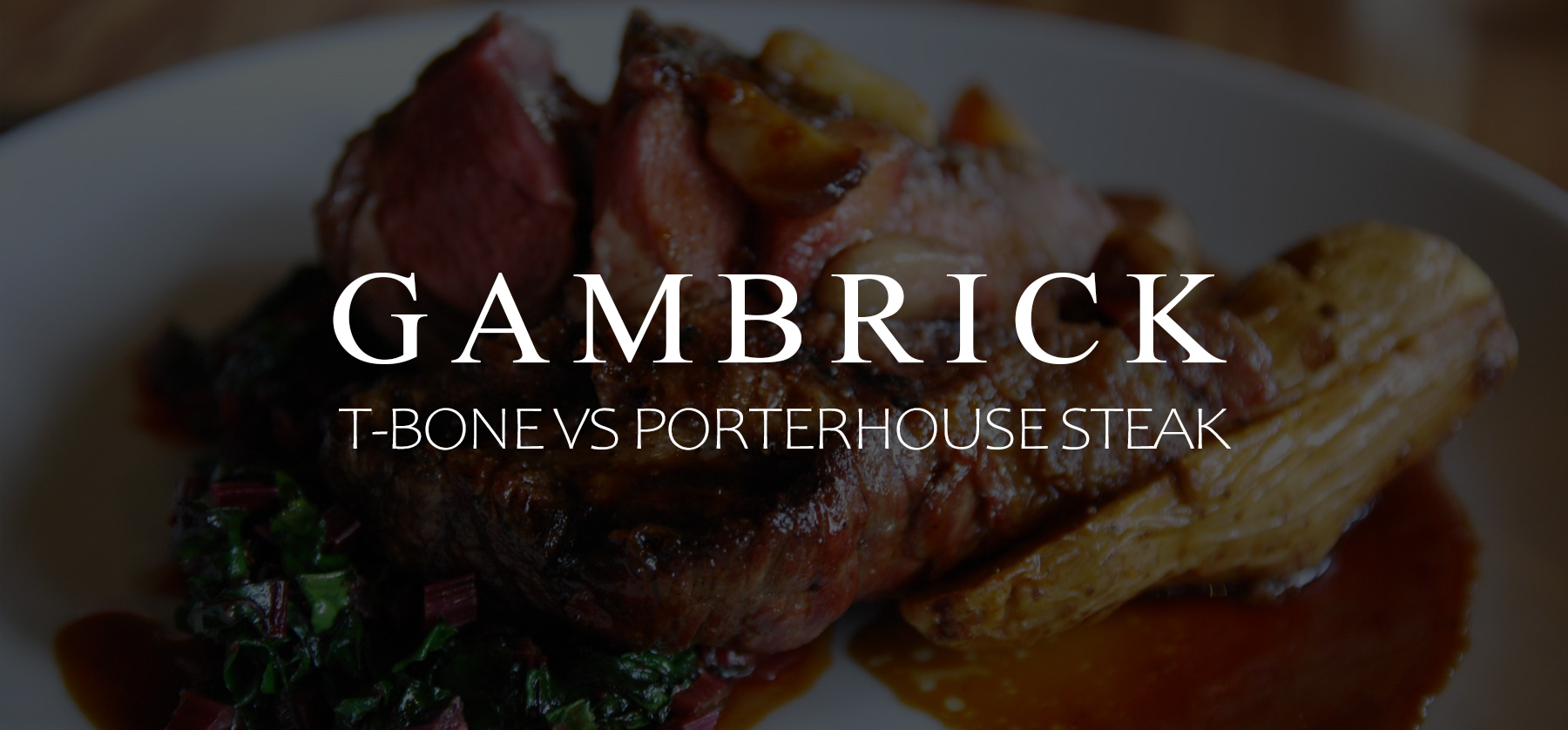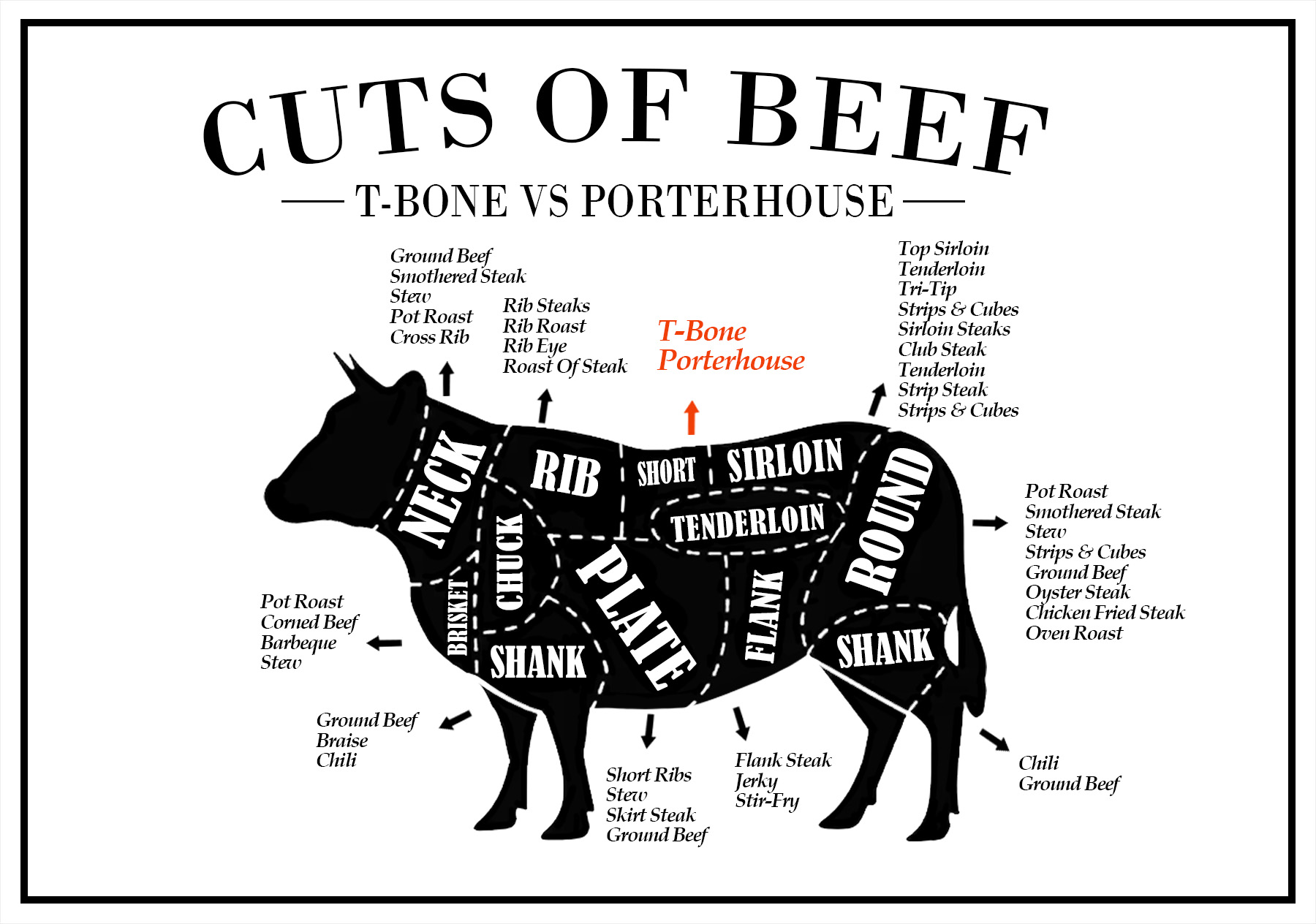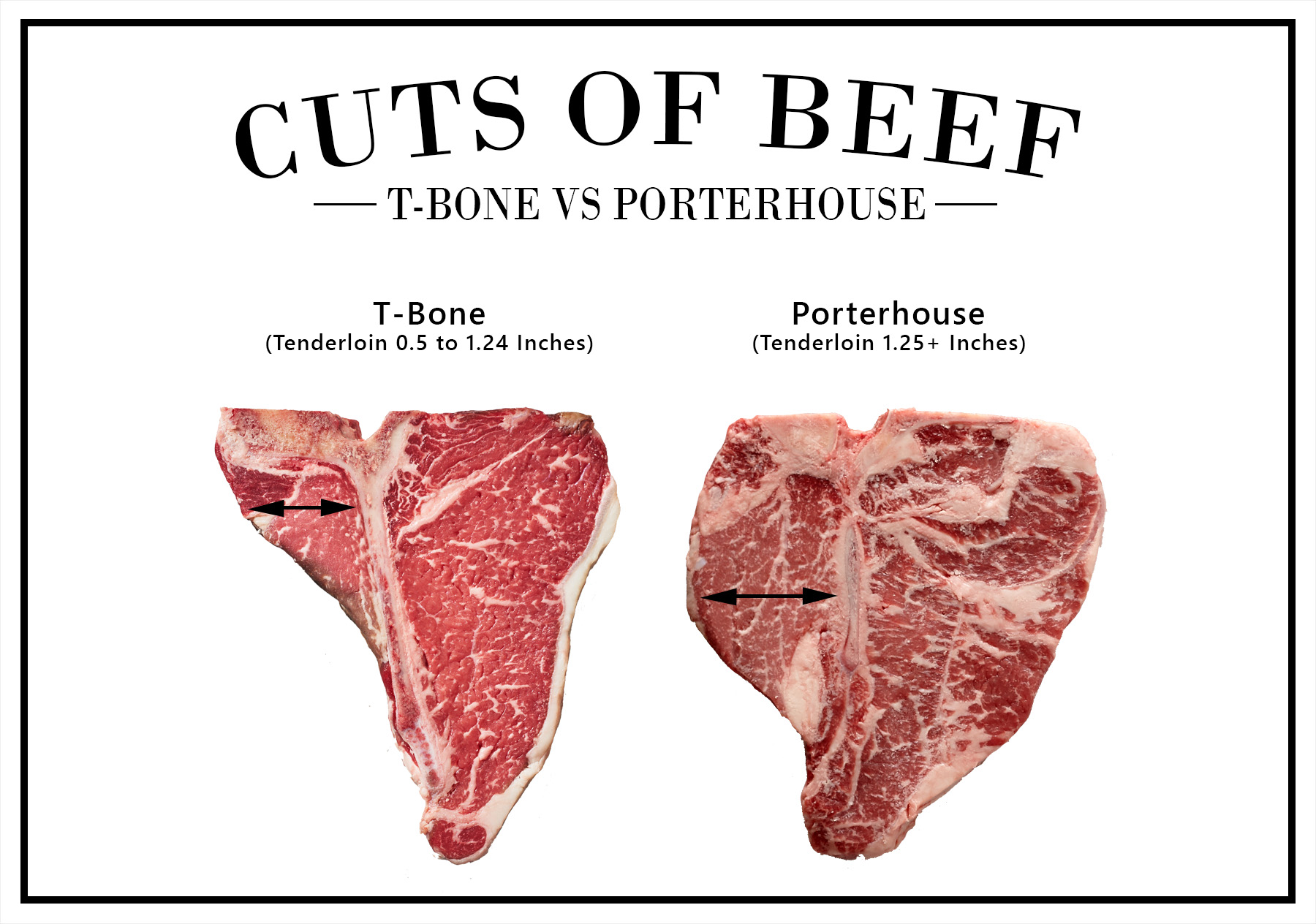T-Bone Vs Porterhouse Steak
T-bone and Porterhouse steaks are two very popular cuts of meat. And although they appear to be the same they’re definitely not. Several organizations have established rigorous guidelines to clarify the similarities and differences between T-bone and porterhouse steaks. Ultimately, the better cut of steak is determined by your personal taste and preferences. Many people find it difficult to select between a T-bone and a porterhouse steak. And honestly, most people don’t understand the differences. This article will simplify things for you by outlining the main distinctions between T-bone vs porterhouse steak. We’ll also detail the preferred selection for most people when ordering at a steakhouse.
T-bone and porterhouse steaks are both cuts of beef from the short loin. Both steaks come with a “T-shaped” bone with flesh on both sides. Porterhouse steaks are cut from the back end of the short loin and hence contain additional tenderloin steak as well as a big strip steak (on the opposite side of the bone). T-bone steaks are sliced closer to the front and have a smaller tenderloin portion.
There is little consensus among specialists on the size of the tenderloin required to distinguish a T-bone steak from a porterhouse steak. According to the USDA’s Institutional Meat Purchase Specifications, the tenderloin of a porterhouse must be at least 1.25 inches (32 mm) thick at its broadest, whereas the tenderloin of a T-bone must be at least 0.5 inch thick (13 mm). Despite being officially a porterhouse, steaks with a big tenderloin are commonly referred to as “T-bones” at restaurants and steakhouses.
Taste and texture are also very similar. When comparing the tenderloin portion of both T-Bone vs Porterhouse steak, I can’t taste or feel a difference.
What Is T-bone Steak?
T-bone steaks are smaller in size than porterhouse steaks. It’s derived from the saddle and is easily identified by the T-shaped bone that divides the sirloin and tenderloin on both sides of the steak.
The side containing sirloin is generally bigger and fatter. Professional cooks use a number of techniques to ensure that all sides are perfectly cooked. A traditional T-bone steak is cooked on the grill, then sliced up against the fibers and rested before being served with garlic-scented butter to enhance the taste.
As an at home chef I love cooking T-Bone steak. I buy mine from a local butcher for around $2.60 an ounce. That’s about $60 for a 24 ounce steak. I don’t mind paying a little more for grass fed. Sometimes I’ll buy T-bones at Costco for less and they’ve always been very good but I do prefer my local butcher’s cuts.
I personally think T-bones are better for home cooking than Porterhouse because they’re smaller and I generally just cook for myself. I like the taste and texture of both but I’m not a huge eater and small cuts of steak are enough for me and easier to cook. If your not a big eater or don’t have the stove to cook big portions I’d recommend the T-bone.
What’s A Porterhouse Steak?
A porterhouse steak is distinguished from a T-bone steak by its bigger tenderloin muscle. It’s a composite steak made from the short loin’s back end, which has the thickest layer of tenderloin.
After removing the bone and cutting out the two steaks that make up a porterhouse steak, you’re left with a top loin and a tenderloin steak. When ordering porterhouse steak, you should usually expect larger quantities because it’s frequently promoted as a dinner for two in steakhouses.
The price of Porterhouse vs T-bone is generally a little less per ounce.
Porterhouse is the better cut for some of my recipes because I need more meat. For example, if I’m making a stew or some steak chili, a porterhouse is great. I also like to cut it up into thin strips for sandwiches or cooked in a pan with garlic, onions and peppers. It’s cheaper than T-bone which is always nice, and I really can’t tell the difference in terms of taste.
Pretty much any time I’m cooking for more than just myself I buy a Porterhouse over a T-bone.
The Differences Between T-Bone & Porterhouse Steak
T-Bone and Porterhouse are very similar steaks. If you only remember one thing about these two steaks, make it this: the porterhouse is a larger version of the T-Bone.
The T-Bone is one of the most distinguishable steaks. It has a T-shaped bone running through it, which makes it simple to identify in a meat case. According to beef industry data, the T-Bone is becoming more popular. This is mainly due to the fact that’s T-bones are all tenderloin and a smaller cut.
T-Bones are cut from the short loin and have two distinct steaks connected to it. The strip is on the long side.
The tenderloin is located on the smaller side of the T-bone. When the flesh is removed from the bone, it may be sliced into Filet Mignon steaks. Of course, if all of the flesh remains connected to the bone, you get the T-Bone.
Except when it’s a Porterhouse steak.
Remember that the size difference between a T-bone and a Porterhouse lies in the tenderloin. Porterhouse steaks include a much bigger amount of filet meat. T-Bones weigh around 20 oz., while Porterhouses weigh approximately 26 oz.
Grilling rather than pan-frying these big steaks is recommended. The flavor will be amazing whether you use charcoal, gas, or a wood smoker.
Size And Source of Meat
The size of the filet can help you tell the difference between a T-bone and a porterhouse steak. Porterhouse steaks, which contain more filet than T-bone steaks, are generally better for two.
A porterhouse steak should be at least 1.25 inches thick since it is derived from the back of the short loin, where tenderloin is abundant. T-bone steaks have less filet since they are produced from the saddle, which includes tiny quantities of tenderloin.
Preparation
A T-bone steak is designed for grilling. The tenderloin stays soft and delicious while the ample pieces of fat keep the meat wet. The T-shaped bone offers a robust grip for grabbing and flipping the steak without having to cut through the flesh.
The steak should be cooked quickly and with minimum decoration. Try a mild oiling and simple seasoning like salt and pepper.
A porterhouse steak can be grilled, but it’s best cooked in a hot smoking cast iron pan on the stove top or under the broiler. Starting hot and fast creates a nice sear on the surface. Porterhouse steak, unlike T-bone steak, needs more time to prepare depending on how you want the steak cooked. But just like a T-bone, I stick with simple seasonings like butter, salt and pepper.
Appearance
T-bone steaks are recognized by their T-shaped bone which has meat on both sides. They’re made up of less tenderloin and are frequently sliced closer to the front.
Porterhouse steak differs from T-bone in thickness because it contains more tenderloin. Although both steaks have the T-shaped bone, a porterhouse has a larger strip steak and more tenderloin on the other side of the bone.
The best way to tell a Porterhouse from a T-bone is the size. They look very similar but Porterhouse is bigger.
Which Is Better T-Bone Or Porterhouse?
Generally, porterhouse steaks have more filet compared to T-bone steaks. This typically makes them a better meal for two people. The size of a porterhouse steak should be at least 1.25 inches thick. They’re cut from the rear of the short loin where the tenderloin is thick.
Personally I thick the T-bone is better. They’re smaller and I generally cook for just myself so there’s no need for the extra meat that comes with a Porterhouse cut. Although when I cook for groups I buy the Porterhouse.
The taste and texture are the same. I really don’t notice any difference. Although the best ways to cook them vary because of the size difference. T-bones are better for grilling while Porterhouse is better in a hot skillet or broiler.
Individual tastes and preferences always influence the choice between T-bone steak and porterhouse steak. Both steaks are expensive, but a porterhouse can generally feed at least two. The final flavor is determined by the manner of cooking, how long it’s cooked and seasoning.
- T-bone and porterhouse steaks are created from various types of cattle, cook at different speeds, and taste best at different temperatures.
- Porterhouse steaks feature more filet than T-bone steaks and are ideal for individuals who want larger servings for two.
In general, the USDA has requirements about the size of the filet contained in a steak in order for it to be classified as a porterhouse. Keep in mind that while each of these steaks might be served separately from the bone, thickness is not always utilized as a conventional measurement.
Nutrition: T Bone Steak Vs Porterhouse
Few things beat a juicy slab of properly cooked T-Bone or Porterhouse steak.
Red meat is abundant in iron and vitamin B-12, which stimulates the immune system and keeps red blood cells healthy. It’s also high in protein, which is necessary for muscular growth and repair.
Porterhouse steaks are essentially the same as T-bone steaks. Surprisingly, every porterhouse steak is a T-bone steak, but not every T-bone steak is a porterhouse steak. And because they each feature two slices of meat, these steaks are the best of both worlds.
So, what’s the distinction between these two cuts of beef? And how do their nutritional similarities and variances differ?
T-Bone Steak
A T-bone steak is mostly an American cut that comes from the spinal region and contains the least utilized muscles. This beef cut derives its name from the T-shaped lumbar bone that divides the two portions of flesh. It comes from the front region of the steer’s short loin where the narrowing tenderloin resides.
The T-bone steak blends the meaty flavorful strip part with the characteristic tender-filled filet Mignon cut. While most T-bones are sliced about 1 inch thick, it’s not uncommon to find these steaks chopped over 1.5 inches thick.
T-bone steaks are a fantastic cut for grilling in your backyard since most steakhouses cook their beef cuts above an open flame. Just bear in mind that the slimmer tenderloin will cook faster than the other strip side of this dual cut steak. Keep it away from the flames to ensure both sides of the bone are cooked evenly.
The substantial fat content of a T-bone steak, which is cut from underneath a Porterhouse, guarantees that it will stay soft during cooking. A 3-ounce portion of T-bone steak has around 23 grams of protein and nearly one-third of the daily vitamin B12 needed. It also contains adequate amounts of vitamin B6, riboflavin, and niacin, as well as trace elements such as iron, zinc, and selenium.
However, because a T-bone is heavy in cholesterol and fat, it is advisable to consume this cut of beef in moderation.
T-Bone Calories
A single T-bone steak typically has 180 to 210 calories and 14 grams of fat. Saturated fat contributes around one-third of this amount depending on how closely the outer fat is cut and the proportion of marbled fat.
Remember that the average T-bone steak weighs approximately 12-24 ounces. The nutrition per serving should be adjusted based on the size of the steak your eating. Generally nutrition information is calculated by ounce and then adjusted for other ingredients such as oil or butter.
And don’t forget to include those extra calories. An otherwise healthy food can be made unhealthy once you add additional ingredients.
Porterhouse Steak
Porterhouse is a composite steak that’s sliced substantially thicker than a T-Bone steak. They have a significantly greater proportion of tenderloin filet to loin section.
The porterhouse is carved from the bigger tenderloin section, where the tenderloin meets the upper loin. The top loin, also known as a New York Strip, is on one side of the center T-shaped bone, while the tenderloin filet is on the other. According to the US Department of Agriculture, the filet section must be at least 1 and 1/4 inches thick between the broadest edge and the bone to be classified as a Porterhouse steak.
The Porterhouse blends two separate beef cuts. This eliminates the need to make a tough choice between the two. When you order a porterhouse steak expect a big portion. They’re generally more than enough for two.
A porterhouse, which may weigh more than 2 pounds, can be served in slices or whole. They’re an excellent choice for a two-person dinner on any special occasion.
A Porterhouse steak cut from quality tenderloin offers ample amounts of protein, some B vitamins, zinc, and iron. However, because porterhouse steaks typically weigh at least 2 pounds and have over 1,000 calories per pound, the nutritional concerns for this huge steak will ultimately rely on how much you wind up eating.
Porterhouse Calories
Porterhouse steaks are bigger than T-Bone’s which means more calories, fats and other nutrients compared to T-Bones. However, the calories and other macros are basically the same per ounce. The nutrition amounts per serving should be adjusted based on the size of the steak your eating. Generally nutrition information is calculated by ounce and then adjusted for other ingredients such as oil or butter.
Don’t forget to include those extra ingredients. An otherwise healthy food can be made unhealthy once you add additional ingredients.
T-Bone & Porterhouse Steaks
A T-bone steak is essentially two steaks in one cut. They’re commonly crosscut from the front portion of the short loin on a cow’s center back where the tenderloin narrows, with the T-shaped lumbar bone separating the two pieces. The T-bone blends the softness of the tenderloin with the meaty taste of a strip of top loin. They’re often called as a New York strip.
According to the rules, a T-bone must include at least 1/2 inch of tenderloin filet Mignon and be sliced at least 1-inch thick.
T-bone steaks are a favorite choice for special occasions at fancy restaurants and are typically expensive. The premium pricing reflects the cow’s cut, which comes from the spine area and contains the least utilized muscles.
Porterhouse
Porterhouse steaks are similar to a T-bone but bigger in size and typically served without the bone. They’re a large cut of beef that’s generally enough for two people. The Porterhouse has risen in popularity across the United States becoming a fixture of steakhouses worldwide.
- T-bone steaks are traditionally an American cut.
- The strip side of the T-bone is known as the Porterhouse in British Commonwealth countries.
- The tenderloin cut is known as the fillet.
A Porterhouse steak must have a bigger tenderloin filet cut at the widest point to qualify. The USDA specifies that a Porterhouse steak be no less than 1 1/4 inch thick, which corresponds to a 16-ounce serving in restaurants.
Although Porterhouse steaks can be larger than that. It’s very common to find them on restaurant menus ranging from 1.5 inches and weighing 24 ounces to 2.25 inches and weighing 48 ounces.
Which Steak Is More Tender Porterhouse Or T-Bone?
I’ve never found any difference between the Porterhouse and T-bone in terms of tenderness. This is mainly because the cuts are almost identical. The only real difference is size.
However, Porterhouses and T-bone steaks are generally cooked differently which does effect how tender they are.
The T-bone is typically grilled while a Porterhouse is pan fried or cooked in a broiler. Also Porterhouses are more often served off the bone and cut up. All this can greatly change how tender the meat is.
Different cooking methods also dictates other ingredients. Some methods use more butter or oils than others. Basting a Porterhouse in butter with a red hot skillet is much different in terms of tenderness than a grilled T-Bone.
Also how rare you cook the meat makes a big difference. Many Porterhouse recipes, such as chili or stew require a well done cut of meat. However a grilled T-bone can be cooked very rare and tender.
Aside from cooking methods and how much you cook the meat, both cuts are about equally tender.
Is A Porterhouse Steak The Same As A T-Bone Steak?
The T-Bone and the Porterhouse are different names for very similar steaks. But they’re not the same. A porterhouse is a bigger version of a T-Bone.
The T-Bone is one of the most easily-identifiable steaks. It has a T-shaped bone running through it which is why they call it a T-bone.
The T-Bone is cut from the short loin and has two different steaks attached to the bone. On the long side is the strip. On the smaller side of the T-bone is the tenderloin. When that piece of meat is separated from the bone, it can be cut into steaks called Filet Mignon. If you leave all the meat attached to the bone, you have a T-Bone.
Except for when it’s a Porterhouse.
Remember, the difference between a T-bone and Porterhouse is size, specifically on the tenderloin side. The Porterhouse has a significantly larger portion of filet meat. A typical T-Bones weighs approximately 20 oz. while the Porterhouse weighs approximately 26 oz.
Other than size, the T-bone and Porterhouse steaks are essentially the same.
A lot of people will try to tell you there isn’t a difference between a porterhouse steak and a T-bone steak. They’re both large steaks with a T-shaped bone in the middle. And they’re not entirely wrong. But having different portions of meat on the bone changes a lot in terms of cooking methods and preparation which then effects taste and texture.
It’s true that T-bones and porterhouses are cut from the same section of the cattle (the short loin), and both have the same type of meat (the NY strip and the tenderloin filet). But the United States Department of Agriculture, or USDA, has strict rules about how much beef belongs on a porterhouse and T-bone.
Porterhouse Steak Are T-Bones
For a T-bone steak to qualify as a porterhouse, the United States Department of Agriculture says that the filet is required to be at least 1.25 inches thick.
Thickness is measured from the bone to the widest point on the filet. Porterhouse steaks come from the rear of the short loin, where the tenderloin is thickest. The result is a large cut of steak.
Many porterhouse steaks weigh around 24 ounces and are served as meals for two.
But A T-Bone Isn’t A Porterhouse
If a T-bone’s filet falls short of the 1.25 inch thick requirement, it can only be labeled as a T-bone steak. It’s important to note that a T-bone’s filet must be at least 0.25 inches thick to be sold as a T-bone. Otherwise, it might just be sold as a bone-in NY Strip or a Club steak.
Other than the cuts size, there’s no real difference between the Porterhouse and T-Bone. Although the Porterhouse’s extra thickness changes a lot in terms of cooking methods and therefore taste and texture.
Porterhouse vs T Bone: Price
Either a T-Bone or Porterhouse marked with USDA Prime will have the highest cost. This is true of pretty much any cut because USDA Prime are considered a nearly perfect steak with excellent marbling. But, which cut of beef is usually the more expensive one?
Because of their size, porterhouse steaks are generally priced higher than T-bone steaks.But the quality of the steak has a lot to do with it’s pricing. Some porterhouse filets may be uneven with one section being thick and another thin. How the steak is butchered matters in terms of quality and price.
Where you buy the meat has something to do with price too. Buying right from a butcher or farm will have different pricing than a supermarket. Fresher meat usually means a higher cost.
Ultimately, the cost difference comes down to a variety of factors like quality, weight, how long they were aged, and where you buy them.
Cooking Porterhouse vs T Bone
Porterhouse and T-bone steaks cook similarly because they come from the same part of the cow and have the same texture. However, because Porterhouse filets are bigger, they take longer to cook. When you’re doing a reverse sear on a T-Bone or Porterhouse, keep the filet far from the heat source. The two cuts of meat contain different amounts of fat, so they cook differently. The filet will cook much faster than the strip. Subjecting them to equal heat will result in a filet that’s dry and overcooked.
The method of cooking both steaks is usually the same. A cat iron skillet works great. It gives them the ultimate sear and leaves the inside a perfect color.
Generously season the steak with salt and pepper before cooking to help it form a nice crust. I also like to add butter to my steaks. After the steak has crusted, baste it with the butter as it cooks.
You can also finish the steak in an oven tented with aluminum foil. Bring it to the proper internal temperature once the crust is formed in the pan. This locks in juices which results in a tender, tasty steak.
Rubs are also a great way to season a steak. They’re a great way to add taste and variety.
Gas or charcoal grills are a great way to cook a Porterhouse or T-Bone steak too. Sear both sides on the hot side of the grill and then move them over to a lower heat area to finish off cooking the inside. Grills give a steak beautiful grill marks and a fantastic taste.
Whenever you cook a T-Bone or Porterhouse steak, make sure to let it rest for about 10 minutes after you’re done cooking it. This will make the steak more flavorful and tender.
Grilling Tips For Porterhouse & T-Bone
All you really need to season T-Bone or Porterhouse steak is coarse pepper and salt. But feel free to add your other favorite seasonings.
Despite being so close to one another, the strip side and filet side are different, so place your strip side on a hotter section of the grill if you have one. The filet side has less fat so it will cook faster than the strip side.
Preheat your grill to 450°F. Sear for 4-5 minutes per side. Pay attention to grill marks if you want to make a nice presentation with your meat.
Make sure to let your steak rest about 10 minutes after taking it off of the grill to let the juices lock in. This creates a tastier and more tender steak.
Summary: T-Bone vs Porterhouse Steak. Which Is Better?
T-bone and Porterhouse steaks are two very popular cuts of meat. And although they appear to be the same they’re definitely not. Several organizations have established rigorous guidelines to clarify the similarities and differences between T-bone and porterhouse steaks. Ultimately, the better cut of steak is determined by your personal taste and preferences. Many people find it difficult to select between a T-bone and a porterhouse steak. And honestly, most people don’t understand the differences. This article will simplify things for you by outlining the main distinctions between T-bone vs porterhouse steak. We’ll also detail the preferred selection for most people when ordering at a steakhouse.
T-bone and porterhouse steaks are both cuts of beef from the short loin. Both steaks come with a “T-shaped” bone with flesh on both sides. Porterhouse steaks are cut from the back end of the short loin and hence contain additional tenderloin steak as well as a big strip steak (on the opposite side of the bone). T-bone steaks are sliced closer to the front and have a smaller tenderloin portion.
There is little consensus among specialists on the size of the tenderloin required to distinguish a T-bone steak from a porterhouse steak. According to the USDA’s Institutional Meat Purchase Specifications, the tenderloin of a porterhouse must be at least 1.25 inches (32 mm) thick at its broadest, whereas the tenderloin of a T-bone must be at least 0.5 inch thick (13 mm). Despite being officially a porterhouse, steaks with a big tenderloin are commonly referred to as “T-bones” at restaurants and steakhouses.
Taste and texture are also very similar. When comparing the tenderloin portion of both T-Bone vs Porterhouse steak, I can’t taste or feel a difference.
If you have any questions or comments about T-Bone vs Porterhouse Steak Email any time.























